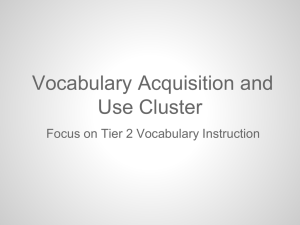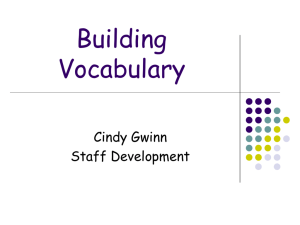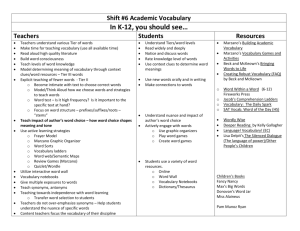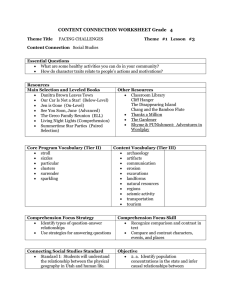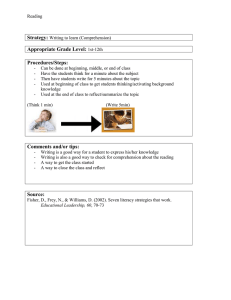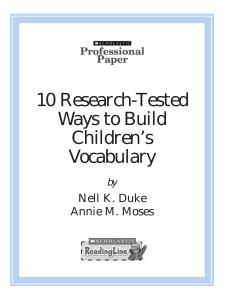Vocabulary Instruction for Students with Autism
advertisement
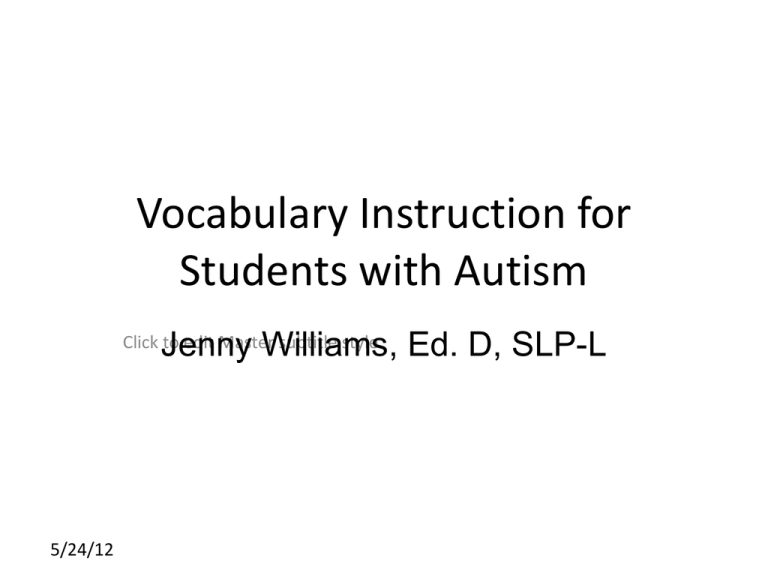
Vocabulary Instruction for Students with Autism Jenny Williams, Ed. D, SLP-L Click to edit Master subtitle style 5/24/12 Today’s Agenda • • Vocabulary development and connections to language and learning Characteristics of vocabulary development in students identified with Autism • Vocabulary assessment • Vocabulary in the GPS • Vocabulary interventions • Using visual representations • Goal Development 5/24/12 What the research says • • • • • Strong connection to reading comprehension and writing skills Evidence that demonstrates that the ability to identify single words is the most important factor accounting for individual differences in text reading fluency for SWD Strong support for selecting vocabulary words that support a child’s classroom reading, use of context and definitions, and use of examples and synonyms to teach word meaning Strong success with use of visual supports such as concept maps and visualizing word meanings and processes that allow chunking, categorizing, and organizing words to determine patterns and relationships Strong support for connecting instruction to true, actual events and providing background information 5/24/12 Vocabulary development in Students identified with Autism • • • • • A pervasive struggle with language and communication skills places this group at risk for ongoing failure in literacy related areas Effectiveness of interventions difficult to assess because of the variability in academic, social, and behavioral functioning at various levels of the spectrum Reading strategies designed to improve the outcomes of students in the general population may have a negative effect for some students with ASD Students with ASD respond better to literacy instruction that is systematic and augmented with strong visual supports Semantic and linguistic aspects of literacy require more innovative and specialized approaches for this group of students 5/24/12 Assessment • Receptive vocabulary tests • Expressive vocabulary tests • Curriculum Based Tests • Broad-based language assessments • Conversation/narrative sampling 5/24/12 Vocabulary Instruction Not all vocabulary knowledge is ‘usable’: • • Almost any kind of vocabulary instruction can improve students’ performance on vocabulary tests But many commonly-used methods of vocabulary instruction do not reliably increase reading comprehension 5/24/12 Vocabulary Instruction Usable vocabulary knowledge • • • Includes competence in the academic register Involves procedural as well as declarative knowledge - learning a word is like learning to use a tool Is generative – it supports the learning of additional words 5/24/12 Number of rare words per thousand words of text • Conversation (college educated) 17 • Prime-time television shows 23 • Preschool books 16 • Children’s books 31 • Comic books 54 • Adult books 53 • Popular magazines 66 • Newspapers 68 5/24/12 Conversational vs. Academic Language Conversation Academic Purpose Maintain relationship Convey information Topic Here-and-now/shared experience Non-present/non-shared experience Relationship Much shared knowledge assumed Less shared knowledge assumed Processing constraints Time constraints No time constraints Feedback Continual feedback Feedback not available Additional channels Gesture, intonation Often no channels besides language Physical environment Can refer to shared physical At a distance in both space & environment time 5/24/12 It’s not just oral vs. written language • • Some uses of written language (e.g., text messaging, informal emails) have communicative purposes more like those of conversation Some uses of oral language (e.g., storytelling) have communicative purposes more like those of academic language 5/24/12 Learn words well enough to use them • To understand text containing that word • To use that word in writing • • To answer vocabulary items on new contextualized tests The need for fluency of word knowledge 5/24/12 More than a definition • Knowing the definition of a word does not provide students enough information to produce meaningful, well-formed sentences using that word (McKeown, 1993; Miller & Gildea, 1987; Scott & Nagy, 1997) 5/24/12 “Vocabulary items will function both as a measure of passage comprehension and as a test of readers’ specific knowledge of the word’s meaning as intended by the passage author.” (National Assessment Governing Board, 2005, p. iv) 5/24/12 For students to learn words well enough to use them, instruction must include: • Both definitional and contextual information (what it means, and how it is used) • Activities that require depth of processing (meaningful use) • Multiple encounters • • Require students to actually use the words (i.e., understand or produce language that uses them) Are sufficiently scaffolded that students who didn’t already know the words can be successful (Stahl, 1986; Stahl & Fairbanks, 1986; Beck, McKeown, & Kucan, 2002) 5/24/12 Activities that involve using the word meaningfully, and are sufficiently scaffold: • • • • Asking students to answer questions that require using their knowledge of the word’s definition (“What is something you might need to confine?”) Asking students to complete a sentence stem (“The two explorers decided they were not compatible because….”) Asking questions that involve pairs of instructed words (“If you assist some new students, will they appreciate it?”) Encouraging and rewarding reports of seeing, hearing, or using instructed words outside of the classroom 5/24/12 More activities that involve meaningful use of instructed words • Asking students to choose which of two scenarios better fits a word, and to defend their choice (“Which is a better example of a strategy – thinking about whether to do your homework before or after you go to the movies, or thinking about what it would be like to have lived 100 years ago?) 5/24/12 Choosing words for instruction / choosing level of intensity of instruction • • • • • Frequency: Does this word occur often enough in written language to make it worth spending time on? Productive control: Do I want my students to be able to use this word? (Is this word a “functional” word?) Distribution: Does this word occur in a variety of genres and subject areas? Role in the lesson / curriculum: Is this word important for what we are learning about? Role in the text: Do I need to know this word to understand the main point of the text? 5/24/12 Why learn academic words? • Lower expectations (about word learning) – • The goal is not to learn what the word means, but to see if one can get enough information about the word to proceed with an acceptable level of comprehension Higher cognitive demands (relating to comprehension) – The goal is not just to learn something about what the word means, but to integrate what one can learn about the word with the rest of the text to construct a coherent meaning 5/24/12 Predicting the Future • Oral vocabulary at the end of first grade is a significant predictor of comprehension ten years later. Cunningham, A.E., & Stanovich, K.E. (1997). Early reading acquisition and its relation to experience and ability 10 years later. Developmental Psychology, 33, 934-945 5/24/12 Dual Coding Theory • Two systems are involved in learning words. One contains verbal information, the other non-verbal (images). When we learn a word, real-world images that we associate with the concept are also stored. Accessing a word in the lexicon therefore involves both the verbal system and non-verbal (imagery) system. • • ~ Moral ~ When teaching new words, use pictures and other 5/24/12 animal The Verbal System mammal “meow” cat dog 4 legs /kat/ pet lion 5/24/12 c-a-t The Nonverbal (Imagery) System 5/24/12 animal mammal “meow” cat dog 4 legs /kat/ pet lion 5/24/12 c-a-t Vocabulary in the GPS • • • • • • ELAKR5: The student listens to a variety of texts and uses new vocabulary in oral language. ELA1W2: The students will write a narrative that begins to use organizational structures (beginning, middle, end and sequence of events) and strategies (transition words and time cue words). ELA3R2: The student reads literary and information texts and incorporates new words into oral and written language. ELA5W2: The student produces a response to literature that lifts the level of language using appropriate strategies including word choice. ELA6RC3: The student demonstrates an understanding of contextual vocabulary in various subjects. L.7.3a Choose language that expresses ideas precisely and concisely, recognizing and eliminating wordiness and redundancy. 5/24/12 Vocabulary Interventions • Dictionary definitions • Student friendly explanations • Resources for vocabulary 5/24/12 How Many Words ???? “a typical third grader likely knows about 8000 words” “attention to a substantial portion of those words, say, an average of 400 per year, would make a significant contribution to an individual’s verbal functioning” 5/24/12 How Many Words ????? • Spelling Words • Tier II Words 10 words per week 11 words per week 36 weeks per year 36 weeks per year 360 words per year 400 words per year 5/24/12 What Type of Words? Tier I Tier II Tier III Basic vocabulary words Sight-based words Important words that have utility (words of mature language users) Content based words that are specific to a given academic area Occur quite often in spoken language Instructional potent (crosses curriculum areas) 5/24/12 Occur frequently during content instruction, but very rarely outside of the Conceptual Understanding given content (e.g., (words that students isotope is used for math sometimes have content, but not generally introductions to, but do outside of math) not necessarily know precision definitions) Let's Look at Tacky ● As I read...identify the Tier II words ● Be prepared to share 5/24/12 Using Visual Representations • Classifying • Describing qualities • Compare/contrast • Part-whole • Cause-effect • Sequencing 5/24/12 Kid Friendly Definations Tame _________________________________________________________________ Friendly and not afraid 5/24/12 To train Kid Friendly Definitions Aggressive ___________________________________________________________________________ To get angry or violent easily 5/24/12 Determined to succeed Parts of Speech tender tendering He is tendering his resignation. ing 5/24/12 present tense verb Synonyms inexperienced Immature Tender impressionable Young green Unsophisicated 5/24/12 Synonyms squashy smooth Tender Soft and easy to chew spongy silky 5/24/12 Synonyms affectionate fond Tender Gentle and loving caring 5/24/12 kind Synonyms propose offer Tender To give or submit present suggest Hand in Put forward 5/24/12 Synonyms raw sore Tender Painful when touched sensitive bruised 5/24/12 painful inflamed Developing and Monitoring Goals • • Tying to content areas Types of words (Tier II vs nouns, verbs, adjectives etc.) • Data collection tools • Analyzing reading and writing samples • What is significant progress for RtI? 5/24/12 Data, Data, and More Data • Qualitative vs Quantitative • Paperwork vs Therapy 5/24/12 References • • • • • • Jordan, G., Snow, C., & Porche, M. (2000). Project EASE: The effect of a family literacy product on kindergarten students’ early literacy skills. Reading Research Quarterly, 35(4), 524-546. Wasik, B., Bond, M., & Hindman, A. (2006). The effects of a language and literacy intervention on Head Start children and teachers. Journal of Educational Psychology, 98(1), 63-74. Beck, I., & McKeown, M. (2001). Text Talk: Capturing the benefits of read-aloud experiences for young children. The Reading Teacher, 55(1), 10-20. Beck, I., & McKeown, M. (2006). Improving Comprehension with Questioning the Author. New York: Scholastic. Johnston, P. (2004). Choice Words: How Our Language Affects Children’s Learning. Portland, ME: Stenhouse. van Kleeck, A., Stahl, S., & Bauer, E. (Eds.) (2003). On reading books to children. Mahwah, NJ: Erlbaum. 5/24/12 References • • • • Beck, I., McKeown, M., & Kucan, L. (2002). Bringing words to life. NY: Guilford. McKeown, M. G., Beck, I. L., Omanson, R. C., & Pople, M. T. (1985). Some effects of the nature and frequency of vocabulary instruction on the knowledge and use of words. Reading Research Quarterly, 20, 522-535. Stahl, S. (1986). Three principles of effective vocabulary instruction. Journal of Reading 29(7), 662-668. Stahl, S., & Fairbanks, M. (1986). The effects of vocabulary instruction: A model-based metaanalysis. Review of Educational Research, 56, 72-110. 5/24/12

